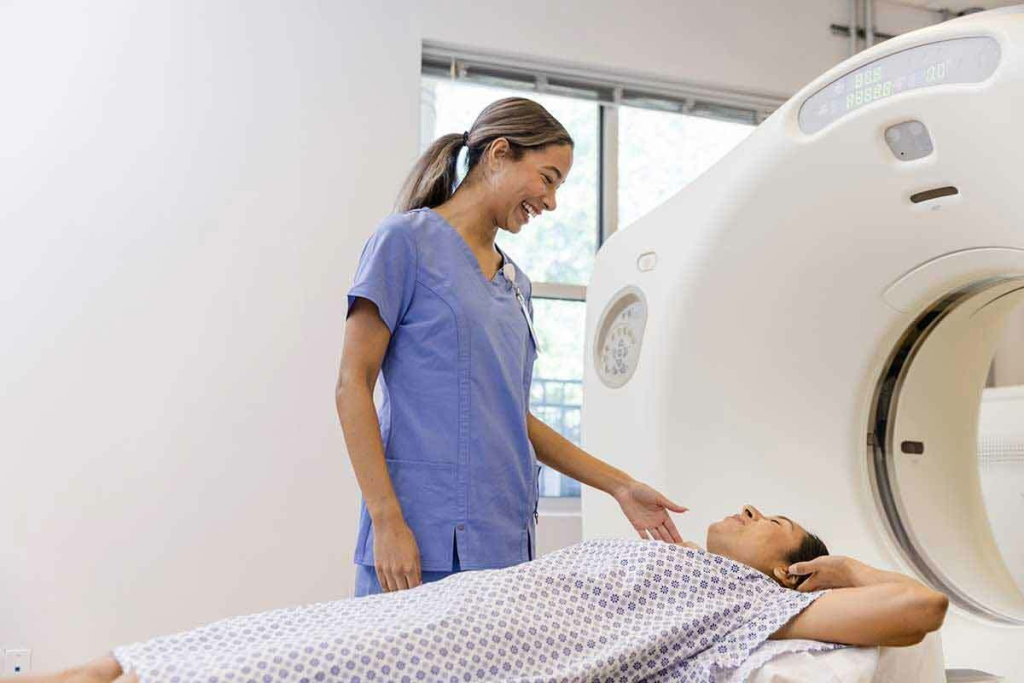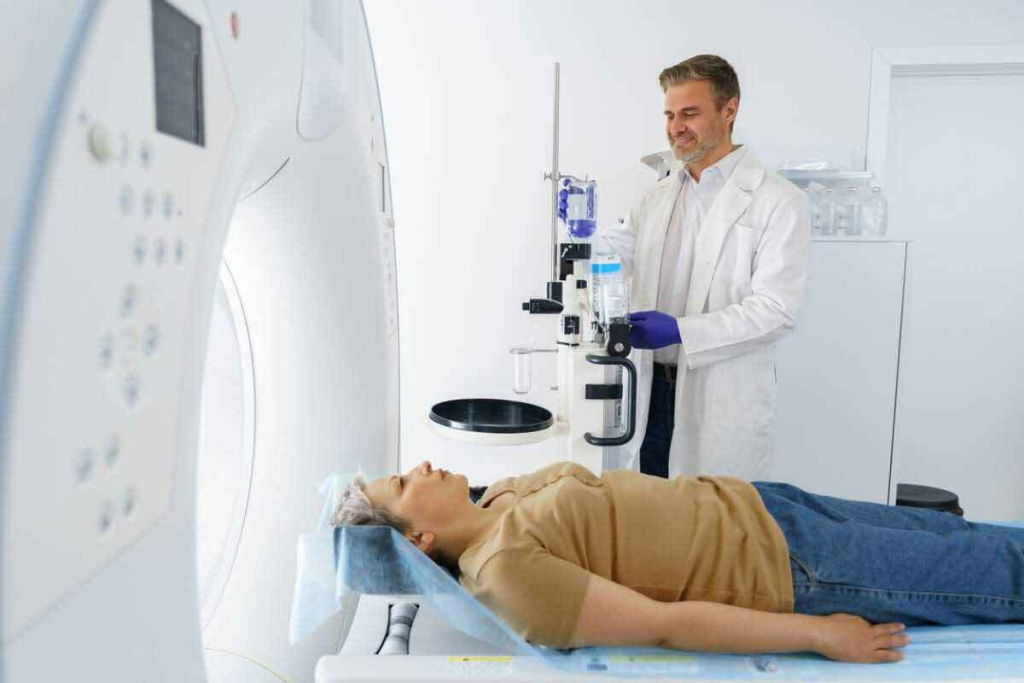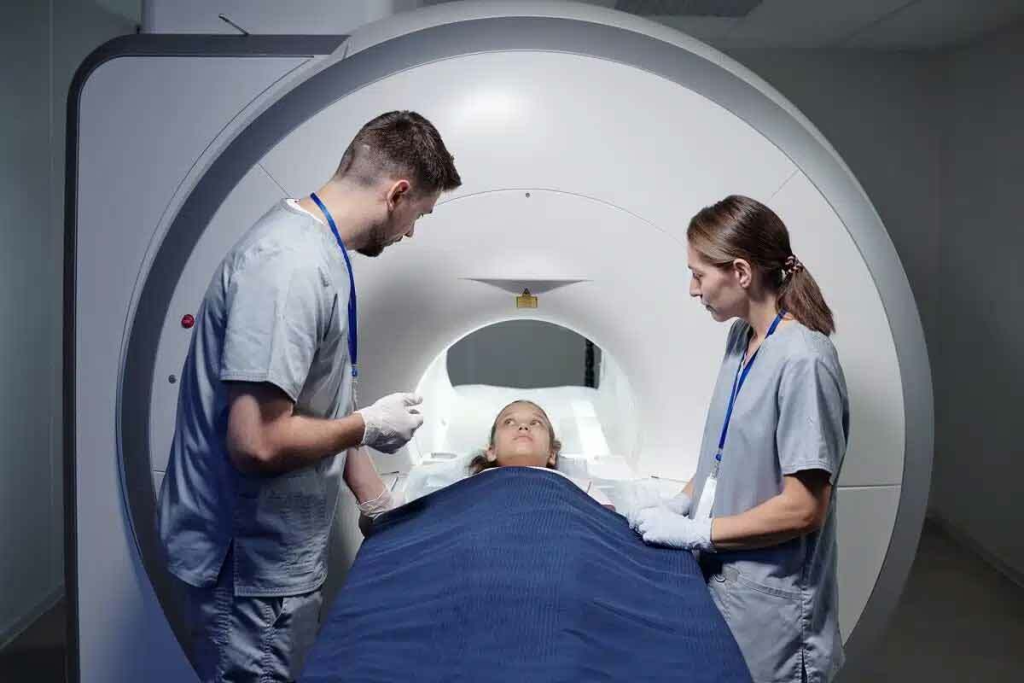
Medical imaging is key in diagnosing and treating health issues. At Liv Hospital, we know picking the right test is vital.
CT scans and ultrasounds are two common imaging methods. They help see inside the body but serve different purposes. It’s important to understand their differences to choose wisely. The term “ct scan sonography” refers to these distinct yet complementary imaging techniques: CT scans use X-rays to create detailed cross-sectional images, ideal for visualizing bones, organs, and detecting tumors, while sonography (ultrasound) uses sound waves for real-time imaging of soft tissues, blood flow, and fetal development without radiation exposure. Understanding the strengths of both helps doctors decide the most appropriate method for each patient.
When deciding on imaging, knowing the differences between CT scan, sonograph,y and ultrasound is key. This article will explore the unique uses and differences of CT scans and ultrasounds.

The field of medical imaging is changing fast, thanks to new tech and healthcare needs. We’re always finding new ways to see inside the body. This is key for modern healthcare.
Medical imaging uses tech to show what’s inside the body. It’s non-invasive, helping doctors diagnose and monitor without surgery. The benefits include:
This tech helps doctors understand what’s wrong and plan better treatments. It leads to better care for patients.
Choosing the right imaging test is ketoor accurate diagnosis and treatment. The choice between CT scans and ultrasound depends on several factors. These include the patient’s condition, the needed detail, and the risks of each.
Healthcare pros must weigh the strengths and limits of each tech. CT scans give detailed images, but an ultrasound is safer and doesn’t use radiation.
Knowing the differences helps healthcare pros make better choices. They balance accuracy with safety and comfort for patients.

To make informed decisions about diagnostic imaging, it’s key to know the basics of CT s,can sonogr,aphy,, and ultrasound. These two imaging methods are vital in modern medicine. They serve different purposes and have unique benefits.
CT scan technology, also known as computed tomography, uses X-rays and computer algorithms to create detailed images. It’s great at showing internal structures like organs and bones. This helps doctors make accurate diagnoses.
Key aspects of CT scan technology include:
CT scans are very useful in emergencies. They can quickly show internal injuries or bleeding.
Ultrasound imaging uses sound waves to create images of the body’s inside. It’s safe and doesn’t use harmful radiation. This makes it great for many patients, including pregnant women.
The process involves:
| Characteristics | CT Scan | Ultrasound |
| Imaging Technology | X-rays and computer processing | High-frequency sound waves |
| Radiation Exposure | Yes | No |
| Primary Uses | Internal injuries, cancers, vascular diseases | Obstetrics, gallbladder disease, liver disease |
Knowing these basics is important. It helps us see the differences between CT scans and ultrasounds. We’ll explore these differences in the next sections.
CT scans and ultrasounds use different technologies. This affects how they work, their safety, and what they can show us.
CT scans use X-rays to make images. Here’s how it happens: X-rays go through the body from a rotating frame. The X-rays that pass through are caught on the other side. This info helps create detailed images.
Key aspects of CT scan technology include:
Ultrasound uses sound waves to make images. A transducer on the skin sends out high-frequency sound waves. These sound waves bounce off inside the body and return to the transducer, creating images in real-time.
Key aspects of ultrasound technology include:
| Characteristics | CT Scan | Ultrasound |
| Imaging Technology | X-ray transmission and detection | Acoustic reflection |
| Radiation Exposure | Yes, uses X-rays | No, radiation-free |
| Image Type | Cross-sectional, detailed | Real-time, dynamic |
CT scans and ultrasounds have big differences in radiation exposure and safety. This is important for patients and doctors when choosing a test.
CT scans use ionizing radiation. This can raise cancer risk, mainly in kids and young adults. The dose depends on the scan type, body part, and technology.
Key Considerations for CT Scan Radiation:
Ultrasounds use sound waves, not radiation. This makes them safer for pregnant women and kids.
Benefits of Ultrasound’s Radiation-Free Technology:
| Characteristics | CT Scan | Ultrasound |
| Radiation Exposure | Involves ionizing radiation | No radiation exposure |
| Safety Profile | Risk of radiation-induced cancer | No known risks associated with radiation |
| Use in Pregnancy | Generally not recommended | Preferred for fetal imaging |
Knowing these differences helps make better choices for imaging tests. CT scans are useful but have radiation risks. Ultrasounds are used for some cases.
Image resolution and diagnostic detail are key differences between CT scans and ultrasounds. These factors greatly affect their ability to diagnose and treat patients. Clear, detailed images are essential for good patient care.
We will look at how CT scans and ultrasounds differ in these areas. We’ll see what each modality is good at and where they fall short.
CT scans are known for their high-quality images and ability to distinguish between tissues. They can spot small differences in tissue density. This makes them great for finding complex conditions. CT scans show detailed pictures of inside structures, helping doctors find problems that other tests can’t.
Ultrasound technology gives real-time images and good views of soft tissues. It doesn’t match CT scans in tissue detail. But ultrasound’s dynamic imaging lets doctors see moving parts, like blood flow and organ function. This is why ultrasound is good for guiding treatments and watching certain conditions.
Ultrasound image quality depends a lot on the operator’s skill and the technology used. New ultrasound tech has made images better, making it a key tool in many medical situations.
It’s key to know how CT scans and ultrasounds are used in medicine. Each has its own role in diagnosing patients. Their strengths and abilities guide their use.
CT scans shine in emergencies. They give quick, detailed views of inside injuries or issues. They’re used for:
CT scans provide high-resolution images. These are vital for quick, accurate diagnoses in emergencies.
Ultrasounds are top picks for many uses. They’re great for:
Ultrasounds are best when you want radiation-free imaging or need to see things in real-time.
CT scans and ultrasounds serve different purposes but work together in care. For example, a CT scan might first check a complex issue. Then, an ultrasound could follow up or help with specific treatments. This way, doctors use each tool’s best features for better care.
In short, picking between CT scans and ultrasounds depends on the situation. Knowing their roles helps doctors choose the best for each patient. This improves care and results.
CT scans and ultrasounds differ a lot in how easy they are to get, how much they cost, and how patients feel during the test. These things help decide which test is best for someone’s needs.
CT scans and ultrasounds have different steps before and during the test. CT scans need more preparation, like fasting or avoiding some medicines. Ultrasounds need almost no prep, making them easier for many people.
For CT scans, you lie on a table that moves into a scanner. You might need to hold your breath briefly for clear pictures. Ultrasounds use gel on your skin and a probe, which is often seen as more comfortable and less scary.
The price of CT scans and ultrasounds can change a lot. It depends on where you go, where you are, and your insurance. Usually, ultrasounds cost less than CT scans, making them a better first choice for many issues.
What your insurance covers and how much you pay out of pocket also matter. Talk to your doctor and insurance to know the costs of your choices.
How comfortable and easy a test is matters a lot. Ultrasounds are liked for being gentle and not using radiation. They’re better for people who need any tests or who are pregnant.
In short, when looking at CT scans and ultrasounds, think about how easy they are to get, their cost, and how they make you feel. Knowing these differences helps patients and doctors choose the best test for each person.
Diagnostic imaging is key in today’s healthcare. Knowing when to use CT scans versus ultrasounds is vital. The choice depends on the patient’s health, the situation, and what’s best for the patient.
Different health issues need different imaging tests. For example, CT scans are best for complex injuries, like those from a car accident. They show detailed images of the inside of organs. Ultrasounds, on the other hand, are great for checking on pregnancies and liver, gallbladder, and kidney problems.
Here are some times when CT scans are usually chosen:
Ultrasounds are often the better choice for:
Doctors carefully think about ordering a CT scan or an ultrasound. They consider the patient’s symptoms, medical history, and what they’re trying to find out. They also weigh the risks and benefits, like radiation and the need for contrast agents.
What’s best for the patient also matters. For example, people who are scared of tight spaces might prefer an ultrasound. Also, patients with kidney disease need to think carefully about CT scans and contrast agents.
We look at these patient-centered factors when picking an imaging test:
| Factor | CT Scan | Ultrasound |
| Radiation Exposure | Yes | No |
| Contrast Agent | Often required | Not required |
| Claustrophobia Concerns | Potential issue | Generally not an issue |
By thinking about these factors and knowing the good and bad of each imaging method, doctors can make choices that meet diagnostic needs while keeping patients safe and comfortable.
CT and ultrasound technologies are getting better fast. This is making diagnosis more accurate and care better for patients. These improvements are making images clearer, exams shorter, and uses wider.
Recently, CT tech has seen big changes. Now, we have high-resolution imaging and less radiation. Modern scanners can take detailed pictures quickly and accurately.
Some big CT tech advancements include:
| Feature | Traditional CT | Advanced CT |
| Image Resolution | Standard | High-Resolution |
| Radiation Exposure | Higher | Lower |
| Scanning Speed | Slower | Faster |
Ultrasound tech is also getting better. We’re seeing better image quality and more functions. New ultrasound systems can do more, helping doctors diagnose in many ways.
Some new ultrasound features include:
As CT and ultrasound tech keep improvingg, they’ll be key in medicine. They give doctors clearer images, leading to better patient care.
Choosing between CT scans and ultrasounds needs a deep understanding of their strengths and limitations’ve looked at the main differences between these imaging methods. This includes their technology, radiation use, image quality, and how they’re used in medicine.
The choice between CT scans and ultrasounds is important for making accurate diagnoses and treatments. CT scans are better for certain conditions because they show more detail. But ultrasounds are a safer choice because they don’t use radiation.
Healthcare professionals must think about what each patient needs when deciding between CT and ultrasound. They consider the patient’s health, what the procedure requires, and how comfortable the patient will be. Choosing the right imaging method helps ensure patients get the best care.
In summary, picking between CT and ultrasound needs a careful look at their strengths and weaknesses. This approach helps us get better diagnostic results and improve patient care.
CT scans use X-rays and computer algorithms. Ultrasounds use sound waves to create images.
Ultrasound is safer because it doesn’t use radiation. CT scans, which use X-rays, carry some radiation risk.
CT scans have better tissue detail and higher resolution. Ultrasounds give real-time images but may not be as detailed.
CT scans are used for detailed views of internal injuries and cancers. Ultrasounds are used for pregnancy, gallbladder issues, and vascular conditions.
Ultrasounds are cheaper and easier to get. This is because they don’t need expensive equipment or radiation safety measures.
Consider the medical condition, the doctor’s advice, and the patient’s needs, like comfort and cost. Also, think about radiation safety.
Yes, both have improved. They now have better image quality, faster scans, and more accurate diagnoses.
While they can overlap, each has its best use. CT scans are better for complex trauma and detailed soft tissue. Ultrasounds are great for obstetrics and some vascular checks.
Ultrasounds are more comfortable and less invasive. They don’t need radiation or contrast agents and are quicker.
Doctors are key in choosing the right imaging. They consider the patient’s condition, medical history, and what they need to diagnose.
“Modern Diagnostic Imaging Technique Applications and Risk. (n.d.). PMC. https://pmc.ncbi.nlm.nih.gov/articles/PMC9192206/
Subscribe to our e-newsletter to stay informed about the latest innovations in the world of health and exclusive offers!
WhatsApp us